Potrebujeme váš súhlas na využitie jednotlivých dát, aby sa vám okrem iného mohli ukazovať informácie týkajúce sa vašich záujmov. Súhlas udelíte kliknutím na tlačidlo „OK“.
ASTM F3036-13
Standard Guide for Testing Absorbable Stents
Automaticky preložený názov:
Štandardné Príručka pre skúšanie vstrebateľných stentov
NORMA vydaná dňa 1.11.2013
Informácie o norme:
Označenie normy: ASTM F3036-13
Poznámka: NEPLATNÁ
Dátum vydania normy: 1.11.2013
Kód tovaru: NS-54884
Počet strán: 9
Približná hmotnosť: 27 g (0.06 libier)
Krajina: Americká technická norma
Kategória: Technické normy ASTM
Kategórie - podobné normy:
Anotácia textu normy ASTM F3036-13 :
Keywords:
absorbable, bend testing, conditioning, degradable, elastic recoil, fatigue, radial loading, securement, stent, stent graft, vascular scaffold, ICS Number Code 11.040.40 (Implants for surgery, prothetics and orthotics)
Doplňujúce informácie
| Significance and Use | ||||||||||||||||||||||||||||||||||
|
4.1 Absorbable cardiovascular stents provide temporary support to the vasculature and are intended to degrade and absorb over time after being implanted into the vasculature. 4.2 The test methods used to evaluate the mechanical performance of absorbable devices are similar to those used to evaluate permanent (non-absorbable) cardiovascular devices. The absorbable-specific pre-test conditioning requirements, handling requirements before and during the test, and time-dependent mechanical property evaluations for absorbable devices are addressed here. 4.3 As the absorbable implant degrades, the mechanical performance of the device also deteriorates. The key to achieving effective revascularization with absorbable devices is to provide an adequate level of luminal support for the time frame needed for vessel stabilization. |
||||||||||||||||||||||||||||||||||
| 1. Scope | ||||||||||||||||||||||||||||||||||
|
1.1 This Guide covers select physical and mechanical characterizations of vascular stents with one or more absorbable components. Such absorbable stents (also referred to as vascular scaffolds) are used to provide temporary luminal support of the coronary and peripheral vasculature following interventional revascularization procedures. This Guide covers devices that are fabricated from one or more degradable polymers and/or metals (from this point on referred to as “absorbable”). This Guide provides a framework for evaluating the change in select physical and mechanical characteristics of absorbable stents from manufacture through their intended degradation 1.2 Recommendations specific to non-absorbable stents with absorbable coatings are not within scope. 1.3 Recommendations specific to testing absorbable stent grafts are not provided here, however this standard has many elements applicable to testing absorbable stent grafts. 1.4 Clinical need dictates that absorbable stents initially possess the same general dimensions and mechanical function as their non-absorbable counterparts. Thus, utilization of already established mechanical stent evaluation methods is possible when absorbable test specimens are previously conditioned under physiologically relevant temperature and humidity. As a result, this standard addresses absorbable-specific testing issues related to the mechanical and physical evaluation of these devices. This standard is limited to providing absorbable-specific testing recommendations for evaluations where an ASTM method for durable (i.e., non-absorbable) stents is already available. Specifically, this standard provides testing recommendations for adapting the elastic recoil (ASTM F2079), securement/dislodgement (ASTM F2394), and three-point bending (ASTM F2606) tests to fully absorbable devices. This guide generally describes specimen conditioning, as appropriate, for absorbable devices, which can range from none to extensive – depending on the measured attribute and relevant clinical exposure conditions, including time in the in-use environment. There are additional stent evaluation methods that are not addressed explicitly in this guide, e.g., chronic durability, that may require absorbable-specific provisions. The user should justify the appropriate testing for the specific polymer and device. 1.4.1 While the primary purpose of this guide is to address absorbable stent-related issues specific to the tests described in Section 1.3, additional testing (e.g., radial strength) will likely also be needed. Thus, aspects of what is presented herein may be applicable to additional relevant device attributes, such as those described in ISO 25539-1 and/or 25539-2. 1.5 This Guide may not be appropriate for all absorbable devices, for example those that possess limited hydrolytic or corrosion susceptibility and degrade 1.6 This Guide does not address the methods necessary to characterize the chemical degradation of the absorbable stent (e.g., changes in mass, molecular weight, or degradants). However, this type of characterization does represent an important component of the degradation profile and mechanism of the device. These characterizations are addressed in ASTM F1635. 1.7 The values stated in SI units are to be regarded as standard. No other units of measurement are included in this standard. 1.8 This standard does not purport to address all of the safety concerns, if any, associated with its use. It is the responsibility of the user of this standard to establish appropriate safety and health practices and determine the applicability of regulatory limitations prior to use. |
||||||||||||||||||||||||||||||||||
| 2. Referenced Documents | ||||||||||||||||||||||||||||||||||
|
Podobné normy:
Historická
1.1.2012
Historická
1.12.2011
Historická
1.10.2012
Historická
1.12.2011
Historická
1.8.2009
Historická
1.9.2006


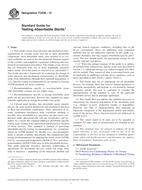
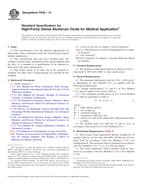 ASTM F603-12
ASTM F603-12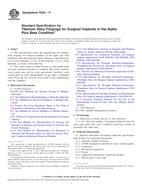 ASTM F620-11
ASTM F620-11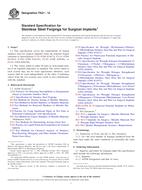 ASTM F621-12
ASTM F621-12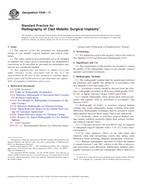 ASTM F629-11
ASTM F629-11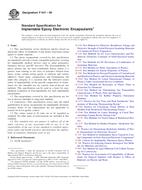 ASTM F641-09
ASTM F641-09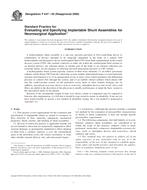 ASTM F647-94(2006)..
ASTM F647-94(2006)..
 Cookies
Cookies
